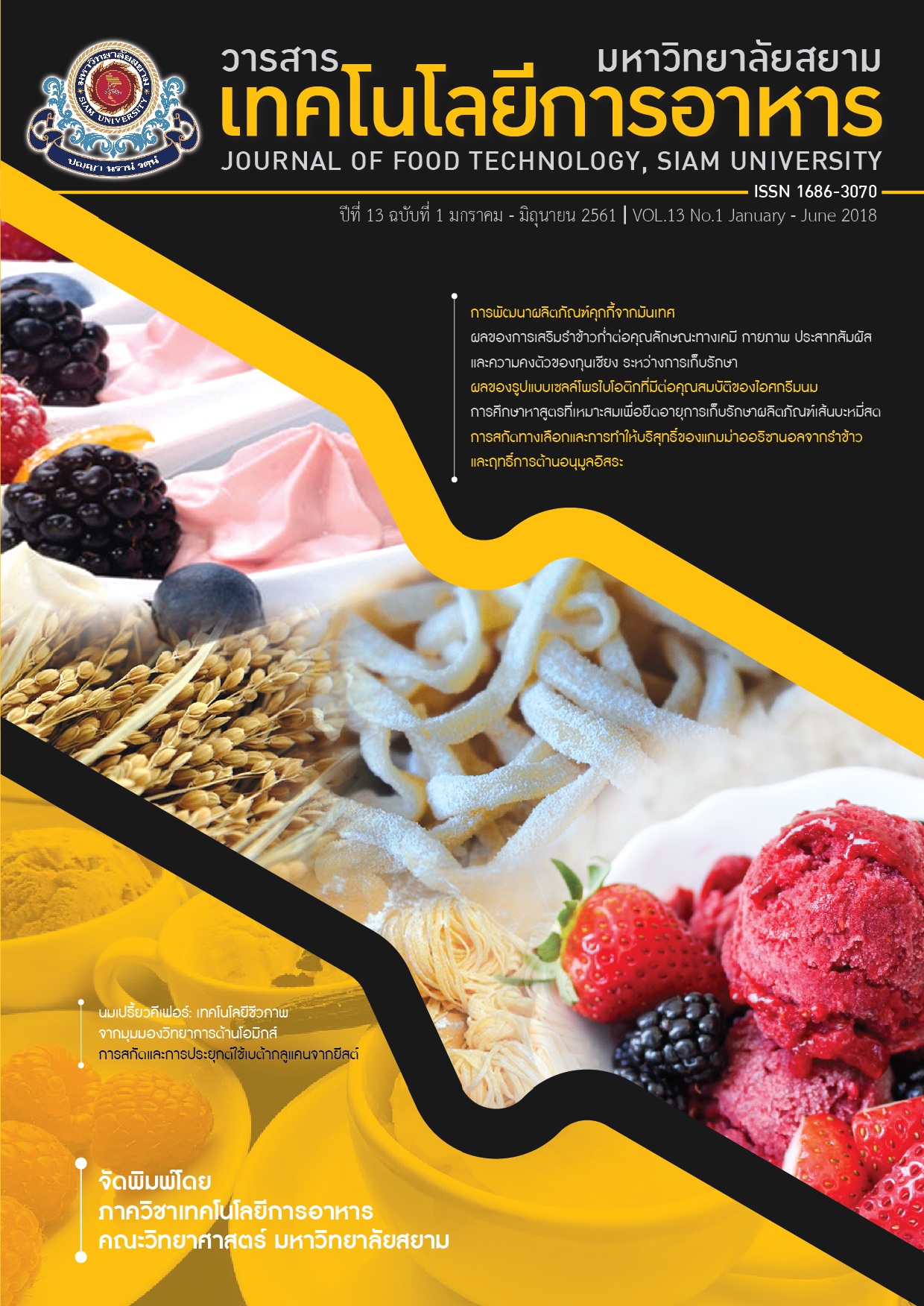การพัฒนาผลิตภัณฑ์คุกกี้จากมันเทศ
Main Article Content
บทคัดย่อ
มันเทศเป็นพืชที่มากด้วยคุณค่าทางโภชนาการ มีคาร์โบไฮเดรตและใยอาหารสูง อีกทั้งยังมีรสชาติที่อร่อยและราคาถูก วัตถุประสงค์ของการวิจัยเพื่อศึกษาผลของอุณหภูมิอบแห้งที่เหมาะสมในการเตรียมแป้งจากมันเทศเนื้อสีขาว สีเหลือง สีส้ม และ สีม่วง และหาอัตราส่วนที่เหมาะสมในการใช้แป้งมันเทศทดแทนแป้งสาลีในผลิตภัณฑ์คุกกี้ การศึกษาอุณหภูมิที่เหมาะสมในการทำแห้งมันเทศด้วยลมร้อนโดยใช้อุณหภูมิ 50 60 และ 70 องศาเซลเซียส พบว่า อุณหภูมิที่เหมาะสมในการอบแป้งมันเทศคือ 60 องศาเซลเซียส เวลา 28 ชั่วโมง ในส่วนของผลิตภัณฑ์คุกกี้ การติดตามการใช้แป้งมันเทศทดแทนแป้งสาลีบางส่วนในการผลิตคุกกี้ โดยการวางแผนการทดลองแบบมิกเจอร์ดีไซน์ (mixture design) ได้สูตรการผลิต 9 สูตร พบว่า สูตรเหมาะสมในการผลิตคุกกี้ประกอบด้วย เนยชนิดเค็ม แป้งมันเทศ แป้งสาลี น้ำตาลไอซิ่ง ไข่ ผงฟู และวานิลา ปริมาณ 40 30 30 30 15 0.5 และ 0.2 กรัม ตามลำดับ ซึ่งเป็นสูตรที่มีคะแนนความชอบรวมสูงที่สุด (7.77±0.82 คะแนน) เกณฑ์ชอบปานกลาง การติดตามปริมาณสารต้านอนุมูลอิสระในคุกกี้แป้งมันเทศ ด้วยวิธี 2,2-diphenylpicrylhydrazyl (DPPH) ปริมาณสารต้านอนุมูลอิสระในคุกกี้แป้งมันเทศเนื้อสีขาว สีเหลือง สีส้ม และ สีม่วง มีปริมาณ 45.20 75.67 93.16 และ 133.59 มิลลิกรัม Trolox ต่อ 100 กรัม ตามลำดับ คุกกี้แป้งมันเทศสีส้มและสีม่วงที่ผลิตได้เป็นคุกกี้ที่มีคุณค่าทางโภชนาการสูง สามารถนำไปพัฒนาต่อยอดการผลิตเพื่อจำหน่ายในตลาดผู้บริโภคที่รักสุขภาพได้ในอนาคต
Article Details
บทความทุกบทความในวารสารเทคโนโลยีการอาหาร ทั้งในรูปแบบสิ่งพิมพ์ และในระบบออนไลน์ ถือเป็นลิขสิทธิ์ของมหาวิทยาลัยสยาม และได้รับการคุ้มครองตามกฎหมาย
เอกสารอ้างอิง
[2] Guoquan, L. and Qainxin, G. (2011). Use of sweet potato in bread and flour fortification, pp. 407-416. In Preedy, V., Watson, R.R. and Patel, V.B. (eds.). Flour and breads and their fortification in health and disease prevention. Academic Press, UK.
[3] Phomkaivon, N., Surojanametakul, V., Poolperm, N. and Satmalee, P. (2016). Changes on physico-chemical properties, total anthocyanin contents and antioxidant activity of different pre-treatment purple sweet potato flour. [Online] Available from file:///C:/Users/ Administrator/Downloads/ KC5106029.pdf [Accessed July, 15, 2016].
[4] Sae-Khow, A., Tirawanichakul, S. and Tirawanichakul, Y. (2013). Effect of drying with heat convection and heat radiation on drying kinetics and quality aspect of black pepper. Burapha Science Journal. 18(1): 166-180.
[5] Duncan, D.B. (1995). Multiple range and multiple F tests. Biometrics. 11: 1–42.
[6] Association of Official Analytical Chemists (AOAC International). (2012). Official methods of analysis (19th edition), Washington, D.C.
[7] Yang, X., Yan, F., Huang, S. and Fu, C. (2014). Antioxidant activities of fractions from longan pericarps. Food Science Technology (Campinas). 34(2): 341-345.
[8] Association of Official Analytical Chemists (AOAC International). (2005). Official methods of analysis (18th edition), Washington, D.C.
[9] Community Product Standards 118/2555. (2012). Cookie. Thai industrial standards institute. [Online] Available from http:// app.tisi.go.th/otop/standard/standards.html. [Accessed July, 15, 2016].
[10] Rattanapanone, N. (2014). Food chemistry. Bangkok. Odian store. 504.
[11] Mordi, R.C. (1993). Mechanism of beta-carotene degradation. Biochemical Journal. 292: 310–312.
[12] Inchuen, S. (2012). Effect of hot-air drying temperature on colo, pasting and antioxidant properties. Khon Kaen Agriculture journal (supplement). 40(1): 478-485.
[13] Sukboonyasatit, D., Ruangsak, B., Srithong, W. and Cheungkuntod, S. (2017). Effect of sweet potato flour as wheat flour substitution on the characteristics of cookies. Khon Kaen Agriculture journal (supplement). 45(1): 1060-1065.
[14] Pornchaloempong, P. and Rattanapanone, N. (2016). Food network solution. [Online] Available from http://www. foodnetworksolution.com. [Accessed July, 15, 2016].
[15] Montilla, E.C., Hillebrand, S. and Winterhalter, P. (2010). Anthocyanin in Purple Sweet Potato (Ipomoea batatas L.) Varieties. Fruit, Vegetable and Cereal Science Biotechnology. 5: 19-24.
[16] Junpatiw, A., Mitmungkorn, Y. and Montri, N. (2017). Effects of heat and storage treatments on the anthocyanin contents in selected purple vegetables. Kaen Agriculture journal (supplement). 45: 1278-1282.
[17] Islam, S.N., Nusrat, T., Begum, P. and Ahsan, M. (2016). Carotenoids and b-carotene in orange fleshed sweet potato: A possible solution to vitamin A deficiency. Food Chemistry. 199: 628-631.
[18] Bovskova, H., Mikova, K. and Panovska, Z. (2014). Evaluation of egg yolk colour. Czech Journal of Food Sciences. 32(3): 213-217.
[19] He, X.L., Li, X.L., Lv, Y.P. and He, Q. (2015). Composition and color stability of anthocyanin-based extract from purple sweet potato. Food Science and Technology (Campinas). 35(3): 468-473.
[20] Ginting, E. (2013). Carotenoid extraction of orange-fleshed sweet potato and its application as natural food colorant. Jurnal Teknologi dan Industri Pangan. 24(1): 81-88.


